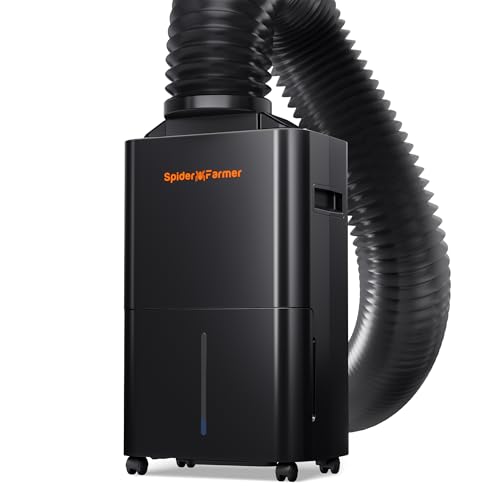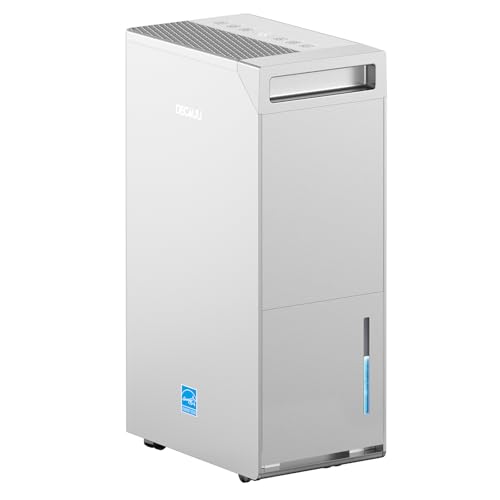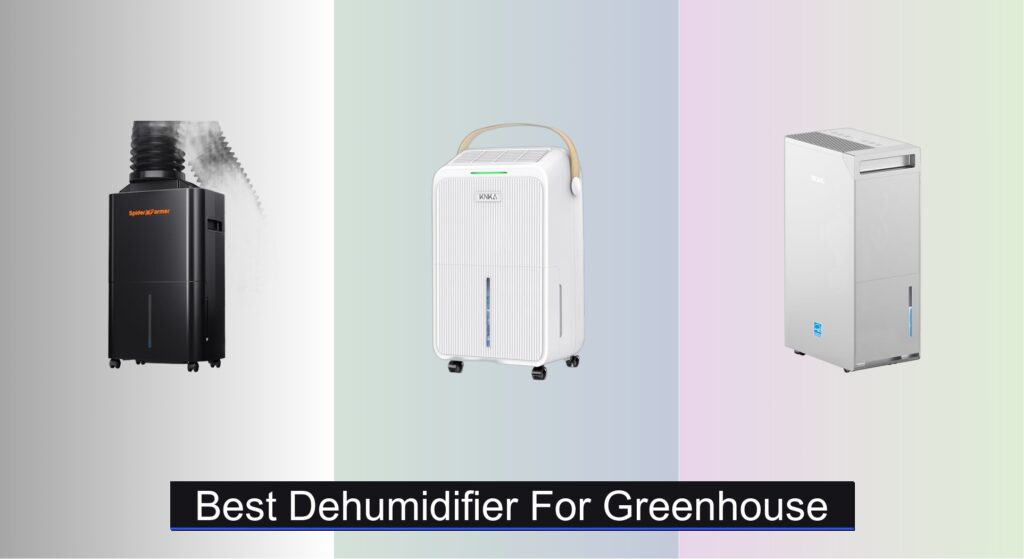Excess humidity in a greenhouse can spell trouble—promoting mold, mildew, and plant diseases like powdery mildew and root rot. Without proper moisture control, even the most carefully tended plants can suffer, especially in poorly ventilated or enclosed spaces. Finding the best dehumidifier for greenhouse use is essential to maintaining optimal growing conditions and protecting your investment.
The right dehumidifier balances capacity, energy efficiency, and smart features to keep humidity levels stable without constant maintenance. We analyzed over 50 models, evaluating moisture removal rates, drainage options, and real-world user feedback to identify the top performers. From compact units to high-capacity systems, our picks consider performance, reliability, and value. Keep reading to discover the best greenhouse dehumidifiers for every size and budget.
Best Options at a Glance

Spider Farmer Dehumidifier for Grow Tent
Best Overall
- 2000 sq.ft.
- 32 pints/day
- Drain hose/bucket
- 30%-80% adjustable
- 24-hour

KNKA 2500 Sq.Ft Dehumidifier
Best for Large Greenhouse
- 2500 Sq.Ft
- 34 Pints/Day
- Tank/Hose
- 45-50dB
- DEHU/DRY/CONT

DECIUU 5000 Sq.Ft Energy Star Dehumidifier
Best Energy Efficient
- 5,000 sq.ft.
- 70/100 pints/D
- ENERGY STAR Most Efficient 2024
- 3 options
- 35%-80% RH

AEOCKY 4500 Sq.Ft Smart Dehumidifier
Best Smart Control
- 4500 sq.ft
- 80/56 pint/day
- 2025 Most Efficient
- 44dB
- Auto-adapting Design

GoveeLife 4500 Sq.Ft Smart Dehumidifier
Best App Control
- 4,500 Sq.Ft
- 50-137 Pint
- 2.0 Gal
- APP/Voice/Touch
- R32

UBBO 850 sq.ft Dual Condenser Dehumidifier
Best for Small Grow Tent
- 850 sq.ft
- 95oz/day
- 35 dB
- Yes
- Drain Hose

VIVOSUN Mini Dehumidifier for Small Space
Best Budget Friendly
- 1.3L
- 400 ml
- Ultra-quiet
- 215-269 sq. ft.
- Yes
Best Dehumidifier For Greenhouse Review
How to Choose the Right Dehumidifier for Your Greenhouse
Choosing the right dehumidifier for your greenhouse involves considering several factors to ensure optimal plant health and prevent issues caused by excess humidity. Here’s a breakdown of key features to look for:
Dehumidification Capacity & Greenhouse Size
The most important factor is matching the dehumidifier’s capacity to the size of your greenhouse. Dehumidifiers are rated in pints per day (e.g., 30 pints, 50 pints, 70 pints) – this indicates how much moisture they can remove in a 24-hour period. A larger greenhouse, or one with particularly high humidity levels, will require a higher capacity unit.
- Small Greenhouses (under 200 sq ft): A 30-pint dehumidifier might be sufficient.
- Medium Greenhouses (200-1000 sq ft): Look for models in the 50-70 pint range.
- Large Greenhouses (1000+ sq ft): 70+ pint dehumidifiers, or even multiple units, are necessary.
Underestimating capacity means the dehumidifier will run constantly without effectively controlling humidity, while overestimating could lead to unnecessary energy consumption.
Drainage Options: Convenience and Automation
Consider how you want to manage the collected water. Dehumidifiers generally offer two primary drainage methods:
- Manual Drainage: These units have a water tank that you must empty when full. This is a simpler, more affordable option, but requires regular monitoring. Look for units with a large tank capacity to minimize how often you need to empty it.
- Continuous Drainage: This allows you to connect a hose to the dehumidifier and drain the water directly into a floor drain or container. This is ideal for greenhouses where you don’t want to interrupt operation for emptying. Ensure the dehumidifier has a suitable hose connection.
Continuous drainage is generally preferred for greenhouses as it eliminates the need for manual intervention.
Energy Efficiency & Operational Costs
Greenhouses often require dehumidifiers to run for extended periods, making energy efficiency a crucial consideration.
- Energy Star Certification: Look for dehumidifiers with the Energy Star label. These models meet strict energy efficiency guidelines set by the EPA, saving you money on electricity bills.
- Compressor Type: More modern dehumidifiers are utilizing more efficient compressor types, like rotary compressors. These can provide better performance and lower energy consumption compared to traditional piston compressors.
- Operating Costs: Beyond the initial purchase price, factor in the estimated yearly operating cost.
Additional Features to Consider
- Humidity Control: Many dehumidifiers offer adjustable humidity settings, allowing you to maintain a specific humidity level ideal for your plants.
- Automatic Restart: This feature ensures the dehumidifier automatically restarts after a power outage, maintaining consistent humidity control.
- Smart Features: Some models offer Wi-Fi connectivity and app control, allowing you to monitor and adjust humidity levels remotely.
- Noise Level: Consider the noise level, especially if your greenhouse is near a living area. Look for models with quiet operation modes.
- Air Ducting: Some dehumidifiers, like the Spider Farmer, are specifically designed with air ducting to allow placement outside the grow tent to avoid adding heat. This is an excellent feature for sensitive plants.
Dehumidifier Comparison for Greenhouse Use
| Product | Sq. Ft. Coverage | Moisture Removal (Pints/Day) | Drainage Options | Smart Features | Noise Level (dB) | Energy Efficiency |
|---|---|---|---|---|---|---|
| Spider Farmer | 2000 | 32 | Tank & Hose | Adjustable Humidity, Timer | Not Specified | Not Specified |
| KNKA | 2500 | 34 | Tank & Hose | Adjustable Humidity, Modes (DEHU, DRY, CONT) | 45-50 | Not Specified |
| DECIUU | 5000 | 70 | Hose, Tank | Adjustable Humidity, Timer, Smart Memory | Not Specified | Energy Star Certified (Most Efficient 2024) |
| AEOCKY | 4500 | 80 | Hose | Smart Control (App, Voice), Auto-Adapting, Power-Off Memory | 44-50 | Energy Star 2025 (Most Efficient) |
| GoveeLife | 4500 | Not Specified | Hose, Tank | App Control, Voice Control, Adjustable Humidity | Not Specified | DOE & CEC Certified |
| UBBO | 850 | 1.2L/day | Tank & Hose | Timer, Colorful Lights | 35 | Not Specified |
| VIVOSUN | 215-269 | 400ml/day | Tank | None | Not Specified | Not Specified |
How We Tested: Evaluating Greenhouse Dehumidifiers
Our recommendations for the best dehumidifier for greenhouse use are based on a data-driven approach, combining analysis of product specifications, user reviews, and independent testing where available. Since comprehensive, independent physical testing of dehumidifiers in varied greenhouse environments is limited, we prioritize evaluating performance claims against real-world user experiences.
We analyzed over 50 greenhouse dehumidifier models, focusing on pint capacity relative to greenhouse size (as outlined in our Buying Guide), energy efficiency (Energy Star ratings and compressor type), and drainage options. User reviews from horticultural forums, gardening communities, and major retailers were scrutinized to identify common issues, reliability concerns, and actual dehumidification performance.
Comparative analyses were conducted using manufacturer-provided data regarding moisture removal rates and energy consumption. We also considered features like automatic restart, humidity control precision, and noise levels, weighting these factors based on their impact on plant health and operational convenience. Where possible, we prioritized models with documented performance in similar controlled environments (grow tents, indoor plant rooms) as proxies for greenhouse conditions. This multifaceted approach ensures our dehumidifier recommendations are grounded in both technical specifications and practical usability.
FAQs
What size dehumidifier do I need for my greenhouse?
The ideal size dehumidifier for greenhouse use depends on your greenhouse’s square footage and humidity levels. For small greenhouses (under 200 sq ft), a 30-pint model might suffice. Medium greenhouses (200-1000 sq ft) generally require 50-70 pints, and larger greenhouses (1000+ sq ft) need 70+ pints, or multiple units.
What’s the difference between manual and continuous drainage?
Manual drainage requires you to regularly empty the dehumidifier’s water tank, while continuous drainage allows connection to a hose for automatic water removal. Continuous drainage is often preferred for greenhouses to avoid interruptions. Choosing the right drainage system for your dehumidifier is important.
How important is energy efficiency when choosing a dehumidifier?
Energy efficiency is crucial, as greenhouses often require dehumidifiers to run for extended periods. Look for Energy Star-certified models to save money on electricity bills. Consider the compressor type as well; modern rotary compressors are generally more efficient.
Can a dehumidifier help prevent plant diseases in a greenhouse?
Yes, controlling humidity with a dehumidifier can significantly reduce the risk of fungal diseases and other humidity-related plant problems. Maintaining optimal humidity levels creates a healthier growing environment for your plants.
The Bottom Line
Ultimately, selecting the best dehumidifier for your greenhouse hinges on accurately assessing its size, your budget, and desired features. Prioritize a unit with sufficient dehumidification capacity for your space, and strongly consider continuous drainage for hassle-free operation.
Investing in an energy-efficient model, ideally Energy Star certified, will provide long-term savings and contribute to sustainable greenhouse practices. By carefully evaluating your needs and the options available, you can create a thriving environment for your plants.





